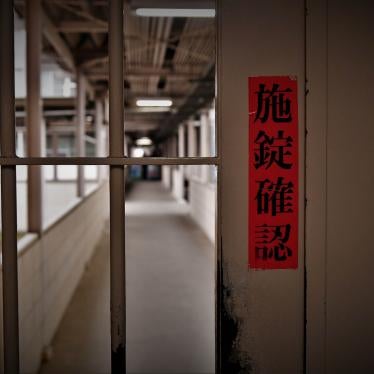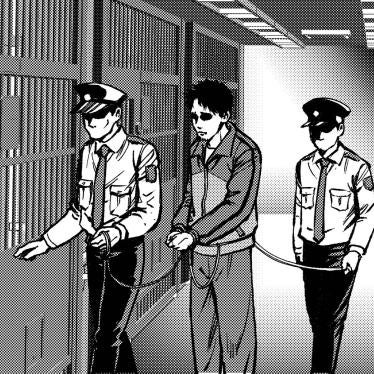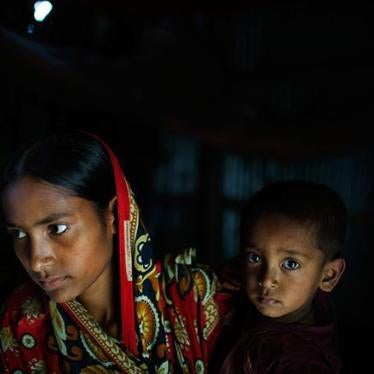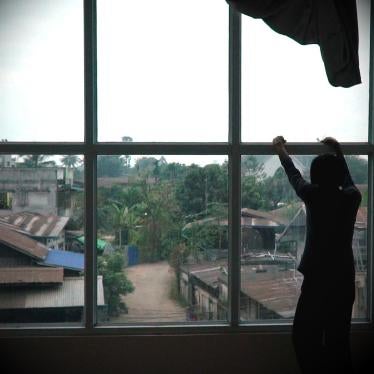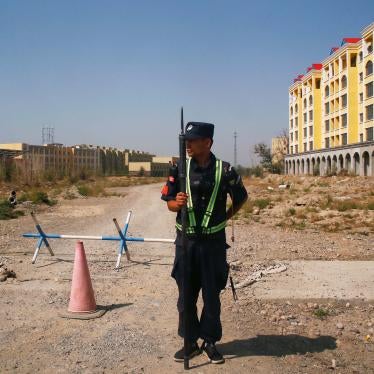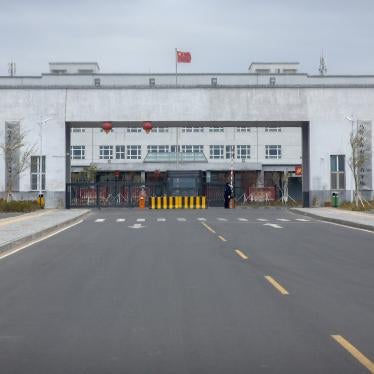(イスタンブール) トルコ史上最悪の炭鉱事故をめぐる裁判が2015年4月13日に開始される。これは被害者にとって裁きを実現する第一歩となると、本日ヒューマン・ライツ・ウォッチは述べた。しかし一方で、政府は労働者の生存権を保障する責任をまっとうしておらず、事故の完全なアカウンタビリティ実現に向け、政府責任の追及が求められる。
2014年5月13日にトルコ西部ソマのエイネズ炭鉱で起きた爆発事故をめぐり、炭鉱運営会社ソマ・クムル社の会長と44人の社員および技師が訴追されている。この事故で301人の作業員が一酸化炭素中毒で死亡、少なくとも162人が負傷した。ヒューマン・ライツ・ウォッチは、多数の生存者および遺族に聞き取り調査を実施。その多くが、当該炭鉱での安全管理および労働環境をめぐり、政府の効果的監視体制がないことに懸念を示していた。
ヒューマン・ライツ・ウォッチのトルコ担当調査員エマ・シンクレア=ウェブは、「ソマ裁判は、被害者に一定の補償を行う機会ではある。が、炭鉱の作業員を保護する義務を怠った政府責任を追及するものではない」と指摘する。「今後トルコ政府が、予防可能な炭鉱事故を再発させることがないようにするためには、政府責任を追及し改善しなくてはならない。」
炭鉱事故の刑事捜査では、労働条件が危険であったこと及びインフラが不適切であったことを示す有力証拠が発見された。検察は炭鉱運営会社が、可燃性ガスの充満レベルとそれに伴う温度の上昇というはっきりとした警告サインを知らされていながら、明らかにそれを無視していた事実を発見。これらが結果として作業員の犠牲につながった。
ソマ・エイネズ炭鉱の作業員および遺族はヒューマン・ライツ・ウォッチに対し、今回の大事故に至るまでの労働条件について詳述。骨抜き検査が日常化していたことや、健康・安全基準の無視、そして多数の作業員に不十分なインフラ・装備・物資しか与えられていなかった点を指摘した。証言者たちは繰り返し、会社側が産炭を最大限にすることに集中し、安全対策は明らかに二の次になっていたと話す。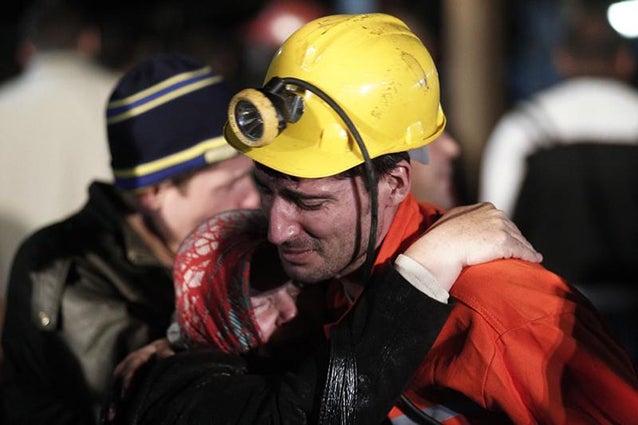
退職したある元作業員は事故で息子を亡くした。「エルドアン首相はこうした炭鉱事故は起こるもので、そういう仕事なのだと言います。でも、私たちにはそんな風に思えません。これは虐殺だ。予防できたはずの事故で政府は保身に回っているのです。」
Akhisar Heavy Penal Courtの裁判では、起訴内容に「相当故意の殺人(killing with probable intent)」から「刑事過失致死(criminally negligent manslaughter)」「構造的殺人(constructive manslaughter)」まで含まれる。被告は操業責任者たちや鉱山技師、そして会長などで、うち8人は公判前から勾留されている。
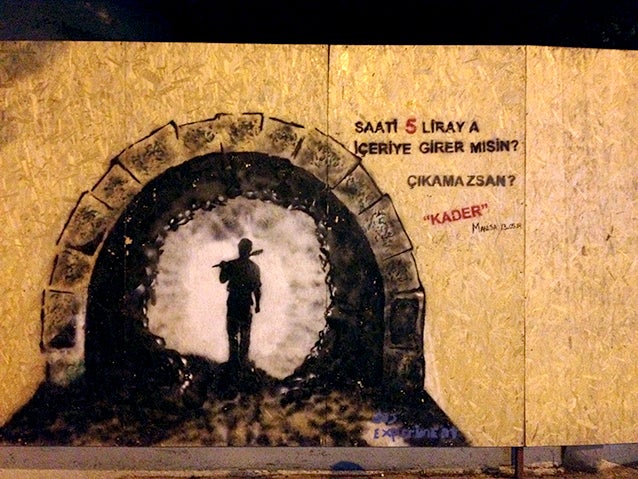
担当検事はこの事故に関して、専門家に対し詳細な鑑定を依頼。これがソマ・クムル社の関係者訴追の根拠となった。同報告書はまた、監視権限を持つ国の検査官および機関も監督義務をたびたび怠ったと指摘し、事故の責任を負っているとしている。
しかし、労働社会保障省とエネルギー天然資源省は、各省関係者に対する刑事捜査の実施許可を与えなかった。国家公務員が職務遂行の過程で犯した犯罪の捜査には行政許可が必要、と定めた国内法を根拠にして捜査を阻止したかたちだ。
前出のシンクレア=ウェブ調査員は、「行政許可に関する古くて議論の多い法律を行使して、国家公務員の犯罪行為に対する検察の捜査を政府が阻止できるという現状は大きな問題だ」と指摘する。「欧州裁判所はこれまで、公務員による犯罪の不処罰につながるとして懸念を示し、トルコにこの法律を廃止するよう要請してきた。」
ソマの大事故で、トルコにおける鉱山業などの有害危険な産業で、劣悪で違法な労働条件が横行している実態に注目が集まった。トルコ南部エルメネクの炭鉱事故でも2014年8月、18人の作業員が犠牲になっており、工事現場での死亡事故も頻繁に起きている。ユーロスタットとトルコ社会保障機関による2011年度のデータをまとめた最新の公式統計によると、トルコにおける労災事故の死亡者数は100万人につき15.4人と、EU28カ国の2.6人を大幅に上回った。そのうちかなりの割合を炭鉱事故における死亡者数が占めている。
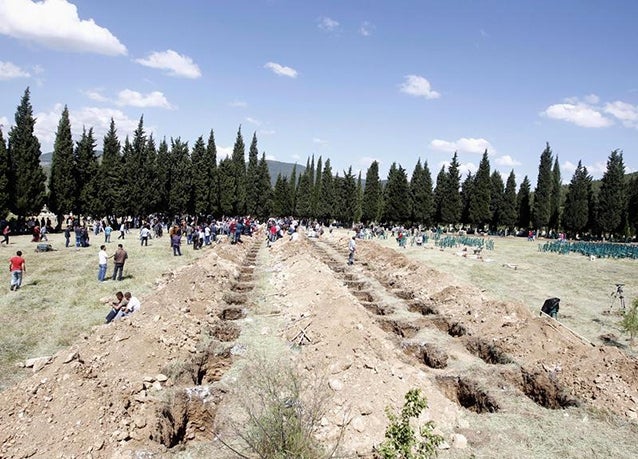
鉱業に関連するトルコの法令は、健康・安全基準を規定しており、各省や機関に対し定期検査および監督の義務を課すものだ。が、労働者保護規準が実際には施行されていないという衝撃的な実態が、ソマの大事故で浮き彫りになった。
前出のシンクレア=ウェブ調査員は、「鉱業をはじめとする有害危険な労働の場合、職場の健康と安全を維持するという政府の義務は、生存権問題に直結する」と指摘する。「さればこそ、ソマの大事故の捜査を行い、責任ある国家公務員の罪を問うことが重要なのである。」
The Search for Justice
Human Rights Watch conducted interviews in the towns of Soma and nearby Kınık and interviewed families of four mine workers who died in the May 13 disaster, nine Soma mine workers, a trade unionist, a lawyer, and a human rights activist. Two of the miners did not want to be identified at all out of concern that they might not get jobs again for speaking out. Others are identified here by their initials.
Relatives of miners who died described their search for justice and of the difficulty of coming to terms with the loss of sons, brothers, and husbands. Their political outlooks varied but their analysis of the causes of the disaster was consistent and matched the findings in the expert report.
A recurring element of their accounts of the disaster and rescue effort was their concern that the mine and its managers prioritized high productivity over obligations to uphold the health and safety of the workforce, and that the state authorities charged with oversight and inspection were fully aware of the situation but ignored it.
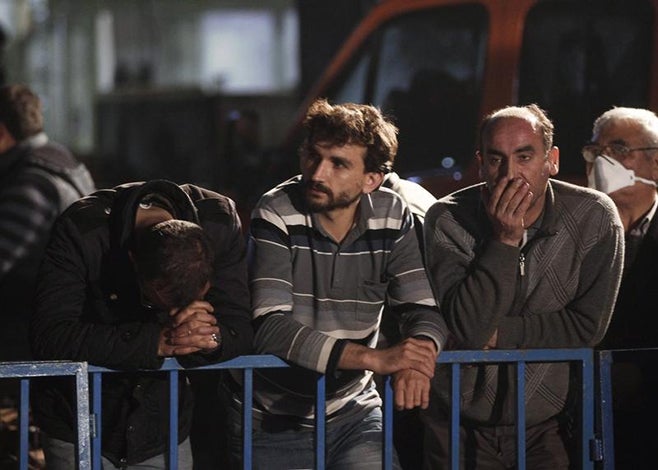
Those interviewed cited a lack of precautions to limit dangerous conditions, a lack of implementation of safety standards, and a lack of training for the miners. Above all, they said there was a lack of effective inspections that might have compelled the mine company to address dangerous working conditions and to uphold its legal obligations to protect workers’ health and safety.
Many also were highly critical of other aspects of mine operations in Turkey, such as subcontracting systems, and said that the Mineworkers Union of Turkey (Türkiye Maden İşçileri Sendikası) had failed to defend their rights at the Eynez mine. Both issues were outside the scope of this research.
Almost one year after the disaster, all of those interviewed in Soma and Kınık expressed feelings of hopelessness and depression, with many saying they had problems sleeping and a loss of interest in life. T.Ç. reported having flashbacks:
There are so many life stories, the story of two brothers who each thought the other was in the mine and went in to rescue the other one. The two died there. Can you imagine? There’s the story of a father and son – and I found them myself. The son had been on the shift and the father went in to find him and save him. He died there too, father and son lying dead with their arms wrapped around each other. For years we saw coal pour off that conveyor belt until the day came when it was our friends’ bodies that were coming off the belt. When I see the conveyor belt I suddenly remember that; I am overcome sometimes. How many times I remember it all every day. Sometimes just from a smell, the smell of death in a glass of water. I can suddenly find myself there again.
Families and wives of miners insisted that all those responsible for the conditions that led to the disaster should be brought to justice. At the same time, none of those interviewed had much confidence in the justice system. I.Ç. said:
The prime minister called the accident fate. He said it was in the nature of the job. But they won’t make any of us see it that way. It was a massacre. It could have been prevented and the state is protecting itself. We will do everything to see the state put on trial as well…430 children are without fathers now. Those who wrote reports giving the mine a clean bill of health should be tried. The ministers should have resigned.
N.K., the wife of a miner who died, said:
Is human life so cheap? We didn’t just lose 301. The whole society here has been left with a deep wound. I waited five days for an identification of my husband’s body from DNA tests. Why is the state protecting the inspectors and not letting them be put on trial? I want to see the state take responsibility for this. Our children are without fathers. I have little confidence in justice in Turkey. As well as my husband last year, seven years ago I lost my brother in a mine accident. No one got a prison sentence. And my aunt’s husband also died in a mine accident before that. There is never justice here.
Forcible police dispersal of protests in Soma to seek justice and the negative attitude of authorities had compounded the sense of injustice. One protester, A.S., said:
We did a two-week sit-in in a park last June, and the police and district governor (kaymakam) told us to get up and that it was a crime, and they detained us. The state commits a crime itself and gets away with it, but when I stand up for my rights, use my democratic rights, I am said to be committing a crime. They use the laws to protect themselves. They don’t give permission to investigate their inspectors for a crime, but they investigate me for a sit-in.
Another miner, E.Ç., said:
I never saw a water cannon vehicle in Soma before May 13. Why bring water cannon? Let people live their pain. We had a demonstration in Soma and blocked the traffic. We did no harm to anyone, not to any shopkeeper or any state institution, and for that the police beat us with batons and teargassed us. In this country you can’t demand your rights, there’s no such thing as demanding rights. If you do it you are deemed the guilty party.
One of the miners, who did not want to be identified, expressed reluctance even to lodge a compensation claim:
I very much want to speak out but I can’t because I am afraid I won’t get work. I got out eight hours after the fire started. We got over that, but now they have ended our work, and we don’t have compensation. Because we joined demonstrations, we may not get work. But we have to work.
All of those interviewed emphasized the enormous pressure placed on the miners to maximize output and the harsh work conditions. F.Ç. was not on the daytime shift on May 13 but rushed to the site when he heard about the fire, knowing his two brothers were both down the mine. He would never see them alive again:
When I once complained about the heat to the chief, he just said, “Is there coal on the conveyor belt, is there output? Forget the rest.” I spent more time crawling on the ground through those narrow passages on my belly than I did during military service. I used to get very angry sometimes about the pressure we were put under. The chiefs were given incentives to produce more but we didn’t see the benefits.
A.S., who was also not at work that day, emphasized the continuing risks:
I think another such tragedy could happen and will happen at one of the mines still open. I think we should put a camera down the mine by the conveyor belt to show the working conditions, to show how the conveyor belt works, to show how people are treated like animals being herded into a barn. There are very hard work conditions down there…The pressure on people in other mines continues. Just imagine that mining is based on planned projects that specify how many people are going to work in the mine. But whatever the project specifies, it’s not like that in practice: because they want to increase productivity they add more people. If it says you have to have five, you’ll find 20 men; if the project says 1,000, you’ll find 3,000.
S.K. worked as a safety officer at the mine but said the mine’s work regime meant he could barely act as one:
There was continually pressure from above so that they would never agree to stopping work to fix things, as it would have interrupted production…On paper there were safety standards but they were never implemented. For instance, a sign saying “Don’t clean the conveyor belt while operating” hung by the conveyor belt but we always had to clean it while it was operating because the company never wanted to halt production.
In 2013, S.Ç.’s left arm got caught in the conveyor belt, leaving him with permanent damage and ending his working life as a miner. His claim against the mine for compensation is ongoing, and he expressed the enormous frustrations that many workers in Turkey experience because of the obstacles they face in securing legal redress for workplace accidents.
Workers also said that the gas masks they were provided were never inspected, repaired, or replaced. E.Ç. said he had the same mask from 2006 to 2014, without it once being examined. “In 2010 there was a fire at the mine as a result of an electrical fault,” he said. “We had to use the gas masks and half of them turned out not to work.” During the May 2014 fire, some masks failed to be effective against the carbon monoxide.
T.Ç. and several others also said that if miners opened theirs masks and used them unnecessarily or lost the mask, the company docked their wages at an inflated cost:
So you’d end up with 1,250 TL (US$486) at the end of the month instead of 1500 TL ($583). And yet we found out afterward that the masks cost just 30 TL. How do you describe that kind of treatment?
The miners Human Rights Watch interviewed repeatedly focused on the lack of proper inspections. F.Ç. said:
If an inspector came, they gave the company notice of their visit well beforehand. Then we had to clear up before they came. The company wouldn’t show the inspectors the very low passages where you had to crawl on the ground. I never saw an inspector in the mine.
E.Ç. said:
Back in March 2011 Labor Ministry inspectors came to the Eynez mine and gathered all the employees and gave us a talk about introducing safety standards as good as the EU’s and making sure not a single worker got injured. The employers stood there saying nothing. I couldn’t stand it and got angry, got up alone and congratulated the inspectors, then said: “But tell me, will you make that a reality in practice? In Turkey, in the private sector, there is no such practice, let’s not kid ourselves.” They assured us they’d stay in Soma a year to implement standards and, if necessary, to impose penalties on the company. But just five months later a friend of ours dies on the job. No one came. The inspectors don’t go underground; they inform the company of their visit 20 days beforehand. Such an inspection isn’t an inspection.
A.A. said:
There are a lot of accidents just because of the lack of oversight and inspection and no investment by private companies in mines.
The Soma Eynez Mine
The Eynez mine was formerly state-run but, in 2006, the state began to lease the mine to private companies to run. The license to run the mine belongs to the Coal Mining Board of Turkey (TKİ), a nominally autonomous body connected with the Ministry of Energy and Natural Resources. In 2006 the board leased the mine to a private company, Park Holding, which reported great difficulties in running the mine because of fires and, in late 2009, applied to discontinue its contract. In 2011 the mine was leased to another private company, Soma Coal Mining, part of the Soma Holding group.
The single client for the lignite coal from the Soma Holding Eynez mine is the state, and the head of Soma Holding stated in a 2012 newspaper interview that his company had succeeded in reducing the cost of coal from $130 to $24 per ton. Soma Coal Mining more than doubled predicted production at the mine in 2013.
After the May 13 disaster, Soma Coal Mining closed the mine where the fire occurred and two other nearby mines. On November 30, 2014, the company laid off 2,181 miners at the Eynez mine and miners at the other two mines that it closed. While some miners have found employment at other mines in the area, the majority remain unemployed. They are entitled to unemployment benefits for just six to eight months.
Mine Safety Concerns and State Responsibility
A 2011 report into mine safety nationwide by the State Inspectorate Board of the Presidency raised detailed concerns and made concrete recommendations about overhauling the sector to improve safety standards. Reports on the Soma mine disaster by Turkey’s Ombudsman Institution, by a parliamentary commission, and by the Turkish Union of Bar Associations all raised grave concerns about dangerous working conditions and the multiple failures of oversight that led directly to the disaster.
In September 2014, parliament passed a law to improve work conditions in mining, reducing the working day from eight to six-hour shifts (with a maximum 36-hour working week), increasing pay, and lowering the retirement age from 55 to 50. The law also stipulated that the state would pay off the debts of families who had lost members in the mine accident and provide employment for one individual in each family, although reportedly this has not yet been implemented.
In March 2015, Turkey ratified the International Labour Organization Safety and Health in Mines Convention (no. 176). Ratification was a positive move, but it will add little to the existing law on the books. The problem is not Turkey’s laws but lack of implementation, Human Rights Watch said.
Turkey’s laws and regulations assign responsibility to a wide range of authorities for ensuring adherence to appropriate technical standards of construction, engineering, maintenance, and practices in mines to ensure occupational health and safety – and for the regular and effective oversight of those standards and practices.
In addition to Labor Ministry inspectors, the agencies involved include the Coal Mining Board of Turkey (TKİ) and its directly affiliated regional office in Soma, Aegean Lignite Operations (Ege Linyitleri İşletmesi Müessesi Genel Müdürlüğü, TKİ-ELİ), and the Mining Works General Directorate (Maden İşleri Genel Müdürlüğü, MİGEM) attached to the Ministry of Energy and Natural Resources.
Government Blocking Investigation into State Responsibility
The prosecutors’ expert report on the Soma mining disaster holds state inspectors and other civil servants responsible for the mine deaths alongside the mine company and its personnel. However, the minister of labor and social security and the minister of energy and natural resources have both refused permission for a criminal investigation that could lead to the criminal prosecution of state officials.
The expert report found that officials had failed in oversight duties in numerous ways. For example, they failed to compel the mine company to replace an air ventilation system that was insufficient for the number of workers employed at the mine and thus contributed to the high number of deaths during the disaster; and over several years prior to the disaster they failed to ensure implementation of health and safety standards in spite of a greatly increased rate of production that should have alerted them to potential safety problems.
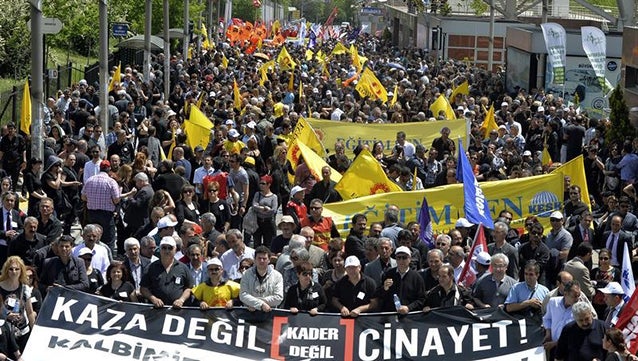
Protesters at a May 15, 2014 demonstration in Ankara criticize the Turkish government for the Soma mining disaster. The banner reads, "Not an accident, not fate, it’s murder!" © 2014 Reuters
In March 2014, two months before the disaster, the record of one government inspection report that Human Rights Watch obtained concludes that over a four-day inspection “no flaw was identified.”
Faruk Çelik, the labor and social security minister, has publicly defended his position:
The prosecutor wanted permission from us for the Soma investigation. I didn’t give it, and why? The perpetrator of the incident was represented as […] my general director of occupational health and safety. He was the man who prepared the law on workers’ safety, so how could he be involved? And they wanted the list of all names of inspectors who had undertaken inspections since 2009 on the grounds that the mine was given its license at that date. But there have been no accidents till this date [May 2014] so why would you want the inspectors’ names. Of course I didn’t accept it. It seems to me ideological to want permission for [investigating] people who were not involved in the incident.
Çelik said that the ministry would conduct its own administrative investigation into two employees instead of agreeing to a criminal investigation, and contended that the disaster was the result of the mine’s outdated structure.
Human Rights Obligation to Conduct a Criminal Investigation
Turkey is a party to the European Convention on Human Rights. The European Court of Human Rights has held, time and time again, that as part of the obligation to protect the right to life in circumstances such as the loss of life at Soma mine there must be an effective investigation capable of identifying all of those responsible with a view to their punishment. The court has emphasized that “any deficiency in the investigation which undermines its ability to establish … the person or persons responsible will risk falling foul of this standard.”
The ministries’ decisions to withhold permission to pursue a criminal investigation of state agents is based on one of Turkey’s most controversial old laws, on the prosecution of civil servants and other public officials (no. 4483). The law stipulates that prosecutors have to secure administrative permission to investigate state officials with a view to prosecuting them for offenses committed in the course of their public duties.
The European Court of Human Rights has repeatedly criticized Turkey for this law on the grounds that state authorities have used it effectively to shield public officials from criminal prosecution and to avoid holding them accountable for serious crimes or abuse of power. Law no. 4483 directly undermines the effectiveness of any investigation, contrary to Turkey’s human rights obligations and its duty to provide victims with an effective remedy, Human Rights Watch said.
In December 2014 Turkey’s highest administrative court, the Council of State, ruled that the labor and social security minister’s decision to withhold permission for a criminal investigation into the ministry’s own inspectors was based on an “insufficient assessment.” The court said the Ministry should conduct a full evaluation of the evidence in the expert report before determining whether to grant permission. This court decision sends the strong message that the ministry should permit an investigation, although it makes no explicit instruction to that effect.
